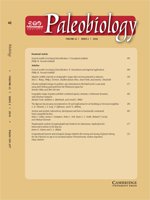New growth rate estimates for nine species from three genera of New Zealand Crassatellidae (Mollusca: Bivalvia), combined with existing morphometric ontogenetic descriptions, allow identification of heterochronic processes in the evolution of these genera. Both paedomorphosis (progenesis and neoteny) and peramorphosis (hypermorphosis and acceleration) have occurred within the clade. Overall, morphological variability and response to environmental pressure in this nonsiphonate group is restricted by the interplay of anatomical and life habit constraints. Stability in the substrate, predator avoidance, sluggish burrowing speed, and inability to escape by deep burial are suggested as key drivers of, or constraints on, morphological change. Two groups of shell characters are identified: heavy, armored “anchors” and elongate “snorkels,” which combine juvenile and adult traits in shells of different sizes and ages, produced by heterochronic variation in developmental timing. Anchors and snorkels both represent different “solutions” to the problems of life as a nonsiphonate, infaunal bivalve.
How to translate text using browser tools
1 May 2016
Anchors and snorkels: heterochrony, development and form in functionally constrained fossil crassatellid bivalves
Katie S. Collins,
James S. Crampton,
Helen L. Neil,
Euan G. C. Smith,
Michael F. Gazley,
Michael Hannah
ACCESS THE FULL ARTICLE

Paleobiology
Vol. 42 • No. 2
Spring 2016
Vol. 42 • No. 2
Spring 2016




